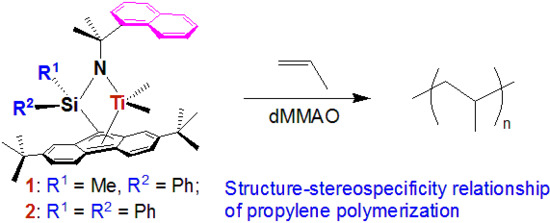Substituent Effects of Phenyl Group on Silylene Bridge in Stereospecific Polymerization of Propylene with C1-Symmetric Ansa-Silylene(fluorenyl)(amido) Dimethyl Titanium Complexes
Abstract
:1. Introduction
2. Experimental Section
2.1. Materials
2.2. Synthesis of Titanium Complexes
2.2.1. Synthesis of (Methylphenyl)silylene-Bridged Ligand L1
2.2.2. Synthesis of (Diphenyl)silylene-Bridged Ligand L2
2.2.3. Synthesis of (Methylphenyl)silylene-Bridged Complex 1
2.2.4. Synthesis of (Diphenyl)silylene-Bridged Complex 2
2.3. Polymerization Procedure
2.4. Analytical Procedure
3. Results and Discussion
3.1. Molecular Structure of Complexes
3.2. Propylene Polymerization
3.3. Mechanical Properties of Polymers
4. Conclusions
Supplementary Materials
Author Contributions
Funding
Acknowledgments
Conflicts of Interest
References
- Brintzinger, H.H.; Fischer, D.; Mülhaupt, R.; Rieger, B.; Waymouth, R.M. Stereospecific olefin polymerization with chiral metallocene catalysts. Angew. Chem. Int. Ed. Engl. 1995, 34, 1143–1170. [Google Scholar] [CrossRef]
- Bochmann, M. Cationic group 4 metallocene complexes and their role in polymerization catalysis: The chemistry of well defined Ziegler catalysts. J. Chem. Soc. Dalton Trans. 1996, 255–270. [Google Scholar] [CrossRef]
- Resconi, L.; Cavallo, L.; Fait, A.; Piemontesi, F. Selectivity in prpene polymerization with metallocene catalysts. Chem. Rev. 2000, 100, 1253–1346. [Google Scholar] [CrossRef] [PubMed]
- Alt, H.G.; Koppl, A. Effect of the nature of metallocene complexes of group Ⅳ metals on their performance in catalytic ethylene and propylene polymerization. Chem. Rev. 2000, 100, 1205–1221. [Google Scholar] [CrossRef] [PubMed]
- Coates, G.W. Precise control of polyolefin stereochemistry using single-site metal catalysts. Chem. Rev. 2000, 100, 1223–1252. [Google Scholar] [CrossRef] [PubMed]
- Ittel, S.D.; Johnson, L.K.; Brookhart, M. Late-metal catalysts for ethylene homo- and copolymerization. Chem. Rev. 2000, 100, 1169–1204. [Google Scholar] [CrossRef] [PubMed]
- Coates, G.W.; Hustad, P.D.; Reinartz, S. Catalysts for the living insertion polymerization of alkenes: Access to new polyolefin architectures using Ziegler-Natta chemistry. Angew. Chem. Int. Ed. 2002, 41, 2236–2257. [Google Scholar] [CrossRef]
- Gibson, V.C.; Spitzmesser, S.K. Advances in non-metallocene olefin polymerization catalysis. Chem. Rev. 2003, 103, 283–316. [Google Scholar] [CrossRef] [PubMed]
- Makio, H.; Terao, H.; Iwashita, A.; Fujita, T. FI catalysts for olefin polymerization—A comprehensive treatment. Chem. Rev. 2011, 111, 2363–2449. [Google Scholar] [CrossRef] [PubMed]
- Mu, H.; Pan, L.; Song, D.; Li, Y. Neutral nickel catalysts for olefin homo- and copolymerization: Relationships between catalyst structures and catalytic properties. Chem. Rev. 2015, 115, 12091–12137. [Google Scholar] [CrossRef] [PubMed]
- Pamela, J.; Shapiro, E.B.; William, P.S.; John, E.B. [{(η5-C5Me4)Me2Si(η1-NCMe3)}(PMe3)ScH]2: A unique example of a single-component α-olefin polymerization catalyst. Organometallics 1990, 9, 867–869. [Google Scholar]
- Okuda, J.; Schattenmann, F.J.; Wocadlo, S.; Massa, S.W. Synthesis and characterization of zirconium complexes containing a linked amido-fluorenyl ligand. Organomtallics 1995, 14, 789–795. [Google Scholar] [CrossRef]
- Waymouth, R.M.; Andrem, L.K. Group 4 ansa-cyclopentadienyl-amido catalysts for olefin polymerization. Chem. Rev. 1998, 98, 2587–2598. [Google Scholar]
- Xu, G. Copolymerization of ethylene with styrene catalyzed by the [η1:η5-tert-butyl (dimethylfluorenylsilyl)amido]methyltitanium “cation”. Macromolecules 1998, 31, 2395–2402. [Google Scholar] [CrossRef]
- Irwin, L.J.; Reibenspies, J.H.; Miller, S.A. A sterically expanded “constrained geometry catalyst” for highly active olefin polymerization and copolymerization: An unyielding comonomer effect. J. Am. Chem. Soc. 2004, 126, 16716–16717. [Google Scholar] [CrossRef] [PubMed]
- Schwerdtfeger, E.D.; Miller, S.A. Intrinsic branching effects in syndiotactic copolymers of propylene and higher α-olefins. Macromolecules 2007, 40, 5662–5668. [Google Scholar] [CrossRef]
- Schwerdtfeger, E.D.; Irwin, L.J.; Miller, S.A. Highly branched polyethylene from ethylene alone via a single zirconium-based catalyst. Macromolecules 2008, 41, 1080–1085. [Google Scholar] [CrossRef]
- Schwerdtfeger, E.D.; Price, C.J.; Chai, J.; Miller, S.A. Tandem catalyst system for linear low-density polyethylene with short and long branching. Macromolecules 2010, 43, 4838–4842. [Google Scholar] [CrossRef]
- Chai, J.; Khalil, A.A.; Miller, S.A. Sterically expanded CGC catalysts: Substituent effects on ethylene and α-olefin polymerization. Dalton Trans. 2013, 42, 9139–9147. [Google Scholar] [CrossRef] [PubMed]
- Jung, H.Y.; Hong, S.D.; Jung, M.W.; Lee, H.; Park, Y.W. Norbornene copolymerization with α-olefins using methylene-bridge ansa-zirconocene. Polyhedron 2005, 24, 1269–1273. [Google Scholar] [CrossRef]
- Kirillov, E.; Razaci, A.; Carpentier, J.F. Syndiotactic-enriched propylene-styrene copolymers using fluorenyl-based half-titanocene catalysts. J. Mol. Catal. A 2006, 249, 230–235. [Google Scholar] [CrossRef]
- Na, S.J.; Wu, C.J.; Yoo, J.; Kim, B.E.; Lee, B.Y. Copolymerization of 5,6-dihydrodicyclopentadiene and ethylene. Macromolecules 2008, 41, 4055–4057. [Google Scholar] [CrossRef]
- Yu, S.T.; Na, S.J.; Lim, T.S.; Lee, B.Y. Preparation of a bulky cycloolefin/ethylene copolymer and its tensile properties. Macromolecules 2010, 43, 725–730. [Google Scholar] [CrossRef]
- Nakayama, Y.; Sogo, Y.; Cai, Z.; Shiono, T. Copolymerization of ethylene with 1,1-disubstituted olefins catalyzed by ansa-(fluorenyl)(cyclododecylamido)dimethyltitanium complexex. J. Polym. Sci. Part A Polym. Chem. 2013, 51, 1223–1229. [Google Scholar] [CrossRef]
- Razavi, A.; Thewalt, U. Preparation and crystal structures of the complexes (η5-C5H3TMS-CMe2-η5-C13H8)MCl2 (M=Hf, Zr or Ti): Mechanistic aspects of the catalytic formation of a isotactic-syndiotactic stereoblock-type polypropylene. J. Organomet. Chem. 2001, 621, 267–276. [Google Scholar] [CrossRef]
- Busico, V.; Cipullo, R.; Cutillo, F.; Talarico, G.; Razavi, A. Syndiotactic poly(propylene) from [Me2Si(3,6-di-tert-butyl-9-fluorenyl)(N-tert-butyl)]TiCl2-based catalysts: Chain-end or enantiotopic-sites stereocontrol? Macromol. Chem. Phys. 2003, 204, 1269–1274. [Google Scholar] [CrossRef]
- Irwin, L.J.; Miller, S.A. Unprecedented syndioselectivity and syndiotactic polyolefin melting temperature: Polypropylene and poly(4-methyl-1-pentene) from a highly active, sterically expanded η1-fluorenyl-η1-amido zirconium complex. J. Am. Chem. Soc. 2005, 127, 9972–9973. [Google Scholar] [CrossRef] [PubMed]
- Nishii, K.; Ikeda, T.; Akita, M.; Shiono, T. Polymerization of propylene with [t-BuNSiMe2Ind]TiMe2-MAO catalyst systems. J. Mol. Catal. 2005, 231, 241–246. [Google Scholar] [CrossRef]
- Tanaka, R.; Chie, Y.; Cai, Z.; Nakayama, Y.; Shinon, T. Structure-stereospecificity relationships of propylene polymerization using substituted ansa-silylene(fluorenyl)(amido)titanium complexes. J. Organomet. Chem. 2016, 804, 95–100. [Google Scholar] [CrossRef]
- Shiono, T. Living polymerization of olefins with ansa-dimethyl-silylene(fluorenyl)(amido) dimethyltitanium-based catalysts. Polym. J. 2011, 43, 331–351. [Google Scholar] [CrossRef]
- Cai, Z.; Su, H.; Shiono, T. Precise synthesis of olefin block copolymer using a syndiospecific living polymerization system. Chin. J. Polym. Sci. 2013, 31, 541–549. [Google Scholar] [CrossRef]
- Cai, Z.; Ikeda, T.; Akita, M.; Shiono, T. Substituent effects of tert-butyl groups on fluorenyl ligand in syndiospecific living polymerization of propylene with ansa-fluorenylamidodimethyl titanium complex. Macromolecules 2005, 38, 8135–8139. [Google Scholar] [CrossRef]
- Kleinschmidt, R.; Griebenow, Y.; Fink, G. Stereospecific propylene polymerization using half-sandwich metallocene/MAO systems: A mechanistic insight. J. Mol. Catal. A Chem. 2000, 157, 83–90. [Google Scholar] [CrossRef]
- Cai, Z.; Su, H.; Nakayama, Y.; Shiono, T.; Akita, M. Synthesis of C1 symmetrical ansa-cyclopentadienylamidotitanium complexes and their application for living polymerization of propylene. J. Organomet. Chem. 2014, 770, 136–141. [Google Scholar] [CrossRef]
- Wang, H.; Wang, X.; Sun, Y.; Cheng, H.; Shiono, T.; Cai, Z. Living polymerization of propylene with ansa-dimethylsilylene(fluorenyl)(cumylamido) titanium complexes. Polymers 2017, 9, 131. [Google Scholar] [CrossRef]
- Sheldrick, G.M. SADABS: An Empirical Absorption Correction Program for Area Detector Data; University of Gottingen: Gottingen, Germany, 1996. [Google Scholar]
- Sheldrick, G.M. Crystal structure refinement with SHEXL. Acta Crystallogr. Sect. C 2008, A64, 112–122. [Google Scholar] [CrossRef] [PubMed]
- Sheldrick, G.M. A short history of SHELX. Acta Crystallogr. Sect. A 2015, C71, 3–8. [Google Scholar] [CrossRef] [PubMed]
- Dolomanow, O.V.; Bourhis, L.J.; Gildea, R.J.; Howard, J.A.K.; Puschmann, H. OLEX2: A complete structure solution, refinement and analysis program. J. Appl. Crystallogr. 2009, 42, 339–341. [Google Scholar] [CrossRef]
- SAINT+, Version 6.22a; Bruker AXS Inc.: Madison, WI, USA, 2002.
- SAINT+, Version v7. 68A; Bruker AXS Inc.: Madison, WI, USA, 2002.
- SHELXTL NT/2000, Version 6.1; Bruker AXS Inc.: Madison, WI, USA, 2002.
- Ioku, A.; Hasan, T.; Shiono, T.; Ikeda, T. Effects of cocatalysts on propene polymerization with [t-BuNSiMe2(C5Me4)]TiMe2. Macromol. Chem. Phys. 2002, 203, 748–755. [Google Scholar] [CrossRef]
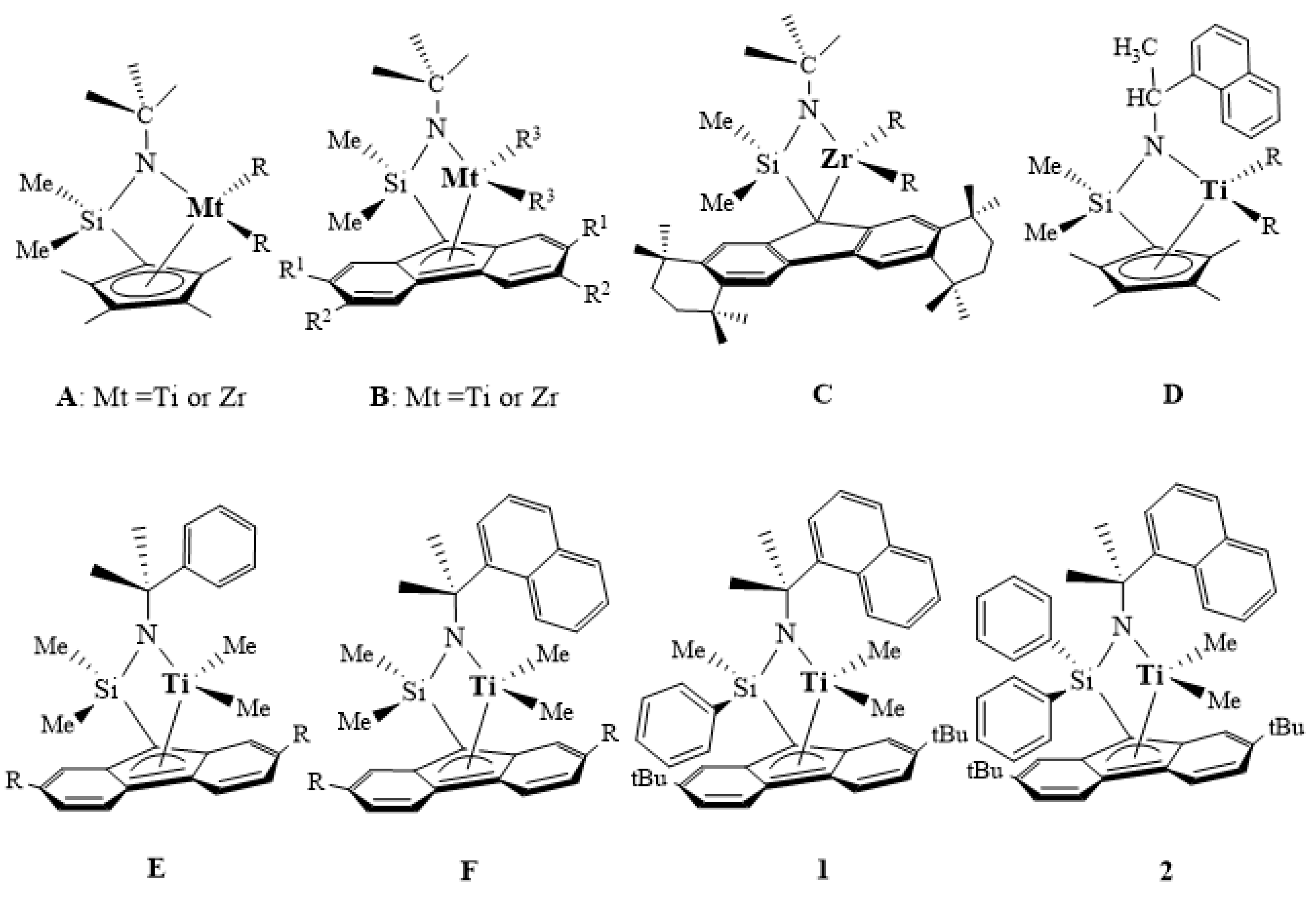
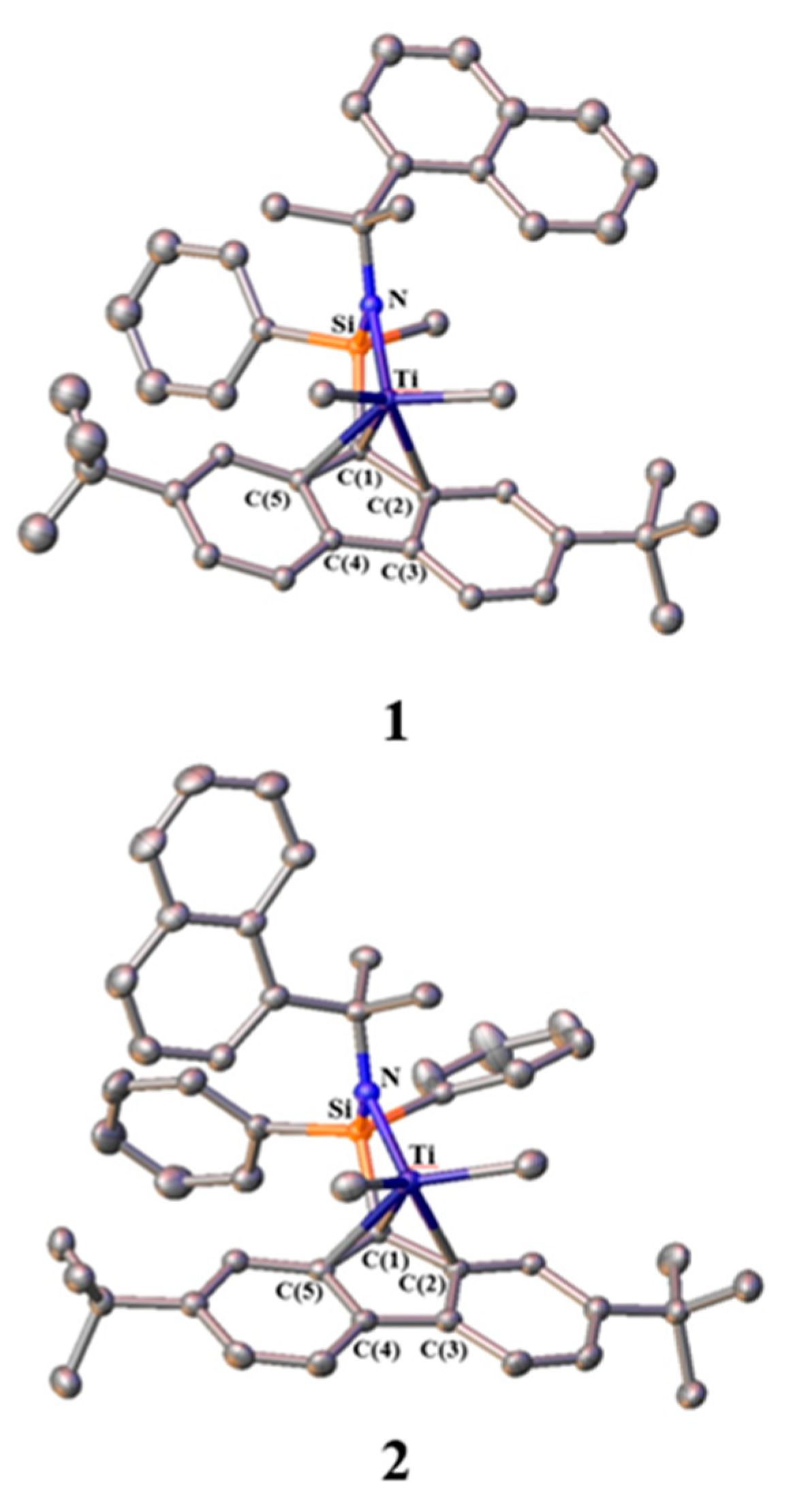
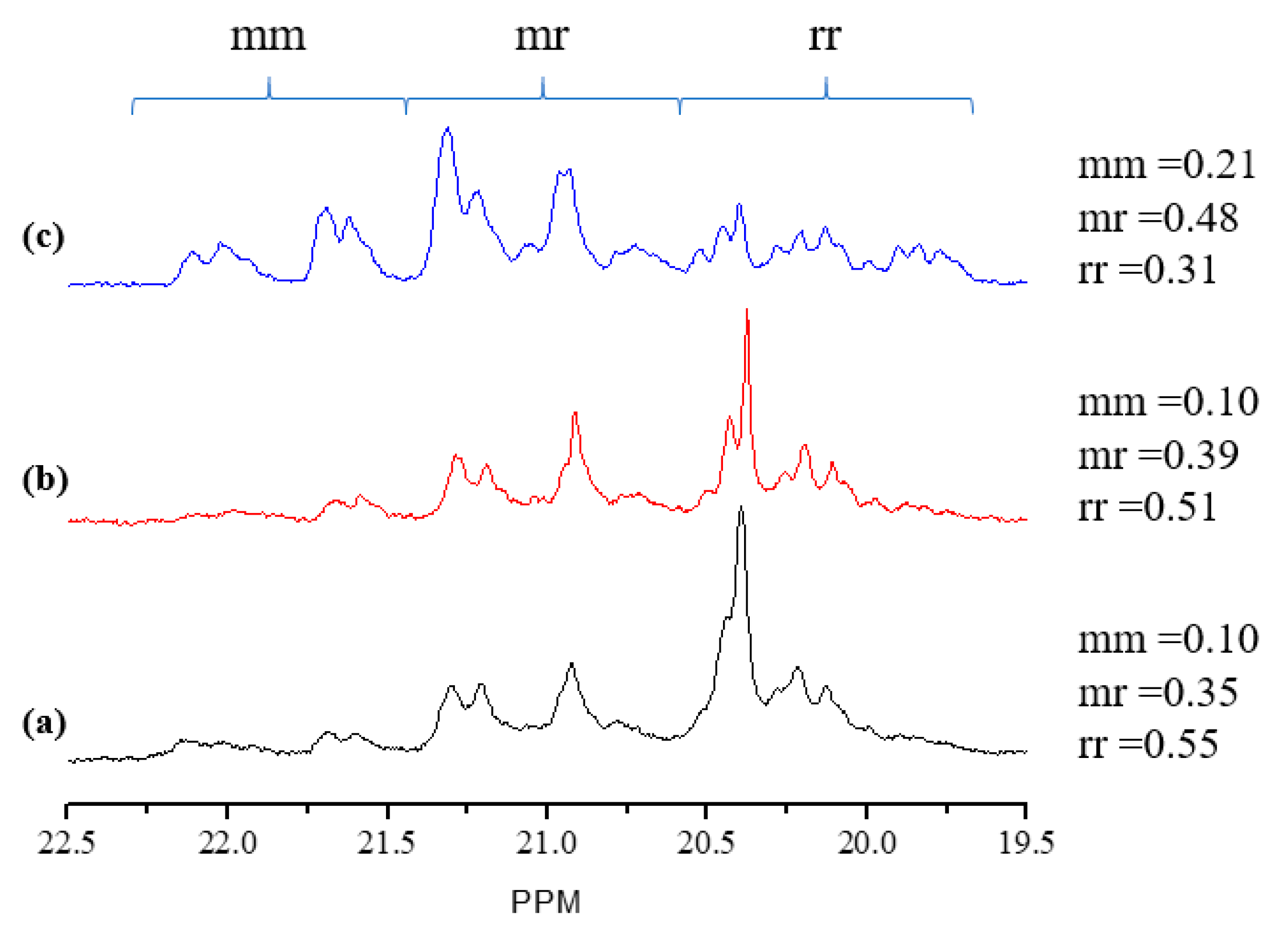
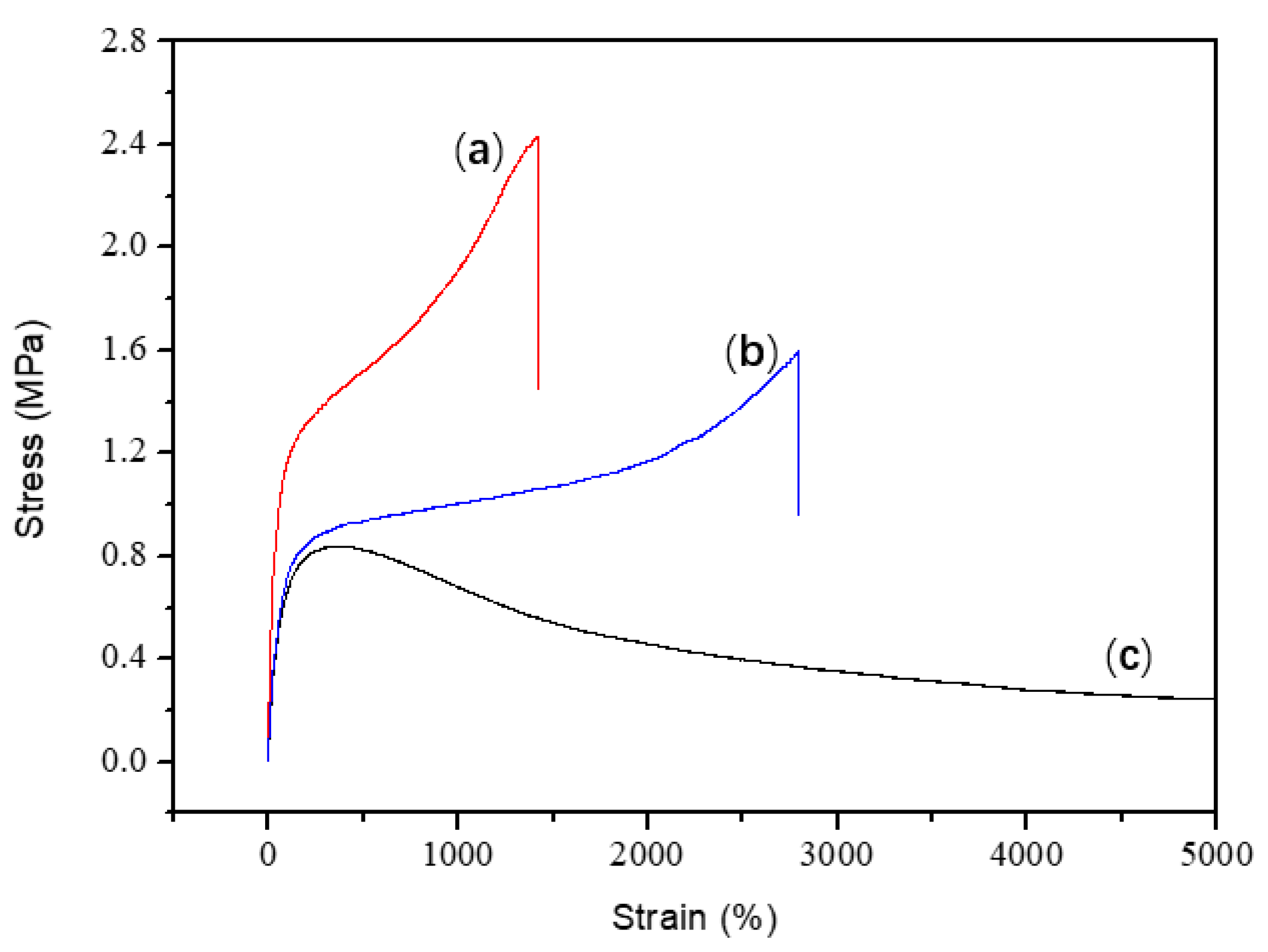

| Complex | 1 | 2 |
|---|---|---|
| CCDC 1539497 | CCDC 1866644 | |
| moiety formula | C46H58NsiTi, 0.5(C6H14) | C48H53NSiTi |
| sum formula | C46H58NSiTi | C48H53NSiTi |
| formula weight | 700.92 | 719.90 |
| crystal system | Triclinic | Monoclinic |
| space group | P | P1 21/c1 |
| a (Å) | 10.3068(10) | 12.3795(12) |
| b (Å) | 13.0737(13) | 9.9527(10) |
| c (Å) | 15.1704(15) | 32.554(3) |
| α (deg) | 98.411(2) | 90 |
| β (deg) | 94.191(2) | 91.065(2) |
| γ (deg) | 93.938(2) | 90 |
| V (Å3) | 2010.3(3) | 4010.3(7) |
| Z | 2 | 4 |
| F (000) | 754 | 1536 |
| density(calcd.) (g·cm−3) | 1158 | 1192 |
| absorption coefficient μ (mm−1) | 0.274 | 0.277 |
| theta range for data collection | 1.922 to 25.497° | 1.251 to 28.362° |
| reflections collected | 14,202 | 33,691 |
| independent reflections | 7483 | 9964 |
| final R indices [I > 2δ(I)] | [R(int) = 0.0258] | [R(int) = 0.0917] |
| R1 = 0.0389 | R1 = 0.0556 | |
| wR2 = 0.0965 | wR2 = 0.1060 |
| Parameter | F [35] | 1 | 2 |
|---|---|---|---|
| Ti–C(1) | 2.267(3) | 2.238(17) | 2.245(3) |
| Ti–C(2) | 2.413(3) | 2.449(18) | 2.441(3) |
| Ti–C(3) | 2.576(3) | 2.638(18) | 2.570(3) |
| Ti–C(4) | 2.569(3) | 2.595(17) | 2.525(2) |
| Ti–C(5) | 2.394(3) | 2.347(17) | 2.370(2) |
| Ti(1)–N(1) | 1.920(2) | 1.934(15) | 1.954(2) |
| Ti(1)–Si(1) | 2.848(11) | 2.846(6) | 2.833(9) |
| N(1)–Ti(1)–C(1) | 77.74(11) | 77.99(6) | 77.41(9) |
| Ti(1)–N(1)–Si(1) | 101.76(12) | 100.89(7) | 100.10(10) |
| N(1)–Si(1)–C(1) | 93.88(13) | 93.32(7) | 94.27(11) |
| Entry | Catalyst | Pressure (atm) | Time (min) | Yield (g) | Activity (kg mol−1 h−1) | Mnb (×104) | Mw/Mnb | Tmc (°C) | Tgc (°C) |
|---|---|---|---|---|---|---|---|---|---|
| 1 | 1 | 1 | 12 | 0 | 0 | - | - | - | - |
| 2 | 2 | 1 | 12 | 0 | 0 | - | - | - | - |
| 3 d | F | 1 | 12 | 0.36 | 91 | 4.38 | 1.27 | - e | −4.3 |
| 4 | 1 | 4 | 20 | 0.54 | 162 | 25.7 | 2.18 | - e | −4.0 |
| 5 | 2 | 4 | 20 | 0.18 | 54 | 13.2 | 2.37 | - e | −3.3 |
| 6 | F | 4 | 20 | 1.20 | 360 | 34.8 | 2.42 | - e | −4.6 |
| 7 | 1 | 8 | 20 | 1.99 | 597 | 54.8 | 2.14 | - e | −3.7 |
| 8 | 2 | 8 | 20 | 0.62 | 186 | 49.3 | 2.05 | - e | −4.0 |
| 9 | F | 8 | 20 | 2.34 | 702 | 60.1 | 1.89 | - e | −3.4 |
© 2018 by the authors. Licensee MDPI, Basel, Switzerland. This article is an open access article distributed under the terms and conditions of the Creative Commons Attribution (CC BY) license (http://creativecommons.org/licenses/by/4.0/).
Share and Cite
Wang, H.; Li, Y.; Cai, Z. Substituent Effects of Phenyl Group on Silylene Bridge in Stereospecific Polymerization of Propylene with C1-Symmetric Ansa-Silylene(fluorenyl)(amido) Dimethyl Titanium Complexes. Polymers 2018, 10, 1075. https://doi.org/10.3390/polym10101075
Wang H, Li Y, Cai Z. Substituent Effects of Phenyl Group on Silylene Bridge in Stereospecific Polymerization of Propylene with C1-Symmetric Ansa-Silylene(fluorenyl)(amido) Dimethyl Titanium Complexes. Polymers. 2018; 10(10):1075. https://doi.org/10.3390/polym10101075
Chicago/Turabian StyleWang, Huajin, Yanqing Li, and Zhengguo Cai. 2018. "Substituent Effects of Phenyl Group on Silylene Bridge in Stereospecific Polymerization of Propylene with C1-Symmetric Ansa-Silylene(fluorenyl)(amido) Dimethyl Titanium Complexes" Polymers 10, no. 10: 1075. https://doi.org/10.3390/polym10101075




